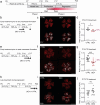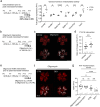This is a preprint.
Timed topical dexamethasone eye drops improve mitochondrial function to prevent severe retinopathy of prematurity
- PMID: 38978601
- PMCID: PMC11230485
- DOI: 10.21203/rs.3.rs-4619093/v1
Timed topical dexamethasone eye drops improve mitochondrial function to prevent severe retinopathy of prematurity
Update in
-
Timed topical dexamethasone eye drops improve mitochondrial function to prevent severe retinopathy of prematurity.Angiogenesis. 2024 Nov;27(4):903-917. doi: 10.1007/s10456-024-09948-2. Epub 2024 Sep 17. Angiogenesis. 2024. PMID: 39287727 Free PMC article.
Abstract
Pathological neovascularization in retinopathy of prematurity (ROP) can cause visual impairment in preterm infants. Current ROP treatments which are not preventative and only address late neovascular ROP, are costly and can lead to severe complications. We showed that topical 0.1% dexamethasone eye drops administered prior to peak neovessel formation prevented neovascularization in five extremely preterm infants at high risk for ROP and suppressed neovascularization by 30% in mouse oxygen-induced retinopathy (OIR) modeling ROP. In contrast, in OIR, topical dexamethasone treatment before any neovessel formation had limited efficacy in preventing later neovascularization, while treatment after peak neovessel formation had a non-statistically significant trend to exacerbating disease. Optimally timed topical dexamethasone suppression of neovascularization in OIR was associated with increased retinal mitochondrial gene expression and decreased inflammatory marker expression, predominantly found in immune cells. Blocking mitochondrial ATP synthetase reversed the inhibitory effect of dexamethasone on neovascularization in OIR. This study provides new insights into topical steroid effects in retinal neovascularization and into mitochondrial function in phase II ROP, and suggests a simple clinical approach to prevent severe ROP.
Keywords: Retinopathy of prematurity; dexamethasone; eye drop; mitochondrial function; neovascularization; oxygen-induced retinopathy.
Conflict of interest statement
Conflict of Interest and Funding Disclosure All the other authors declare that they have no competing interests.
Figures





References
-
- Yossuck P, Yan Y, Tadesse M, Higgins RD (2000) Dexamethasone and critical effect of timing on retinopathy. Invest Ophthalmol Vis Sci 41(10):3095–3099 - PubMed
Publication types
Grants and funding
LinkOut - more resources
Full Text Sources

